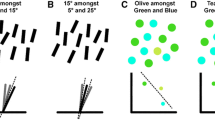Summary
Single line segments titled with 0, 45, 90, and 135 degrees orientation were briefly exposed as stimuli and the subjects had to identify the orientation of a presented line segment. The length of the lines and the exposure duration were varied. The multicomponent theory (Rumelhart, 1970, 1971) was applied to the observed frequencies of a correct response and of some incorrect responses given to a stimulus with a particular orientation, length, and exposure duration. Within the framework of this theory several hypotheses concerning the effects of orientation, length and exposure duration in identification were tested. The main results are: (1) The rate of component detection was higher for the horizontal and vertical orientations than for the two oblique orientations. (2) The number of components in a line segment quite accurately followed a linear function of the line's physical length, and the negatively valued additive constant in this function could not be neglected. (3) The information in the visual information store decayed more rapidly after longer exposure durations and more slowly after shorter exposure durations. These findings are discussed in relation to other research on the subject.
Similar content being viewed by others
References
Appelle, S.: Perception and discrimination as a function of stimulus orientation: The “oblique effect” in man and animals. Psychol. Bull. 78, 266–278 (1972)
Campbell, F.W., Kulikowski, J.J., Levinson, J.: The effect of orientation on the visual resolution of gratings. J. Physiol. 187, 427–436 (1966)
Chandler, J.P.: Subroutine STEPIT: An algorithm that finds the values of the parameters which minimize a given continuous function. A copyrighted program: J.P. Chandler. Quantum chemistry program exchange. Bloomington, Ind.: Indiana University 1965
Feller, W.: An introduction to probability theory and its applications, Vol. II. New York: Wiley 1966
Greeno, J.G., Steiner, T.E.: Comments on “Markovian processes with identifiable states: general considerations and applications to all-or-none learning”. Psychometrika 33, 169–172 (1968)
Haber, R.N.: Where are the visions in visual perception? In: Imagery, current cognitive approaches. (Segal, S.J., Ed.), pp. 33–48. New York: Academic Press 1971
Higgins, G.C., Stultz, K.: Visual acuity as measured with various orientations of a parallel-line object. J. Opt. Am. Soc. 38, 765–758 (1948)
Neyman, J.: Contribution of the theory of the X 2-test. In: Proceedings of the Berkeley symposium on mathematical statistics and probability. (Neyman, J., Ed.), Berkeley: University of California Press 1949
Neisser, U.: Cognitive psychology. New York: Appleton-Century-Crofts 1967
Ogilvie, J.C., Taylor, M.M.: Effect of orientation on the visibility of fine wires. J. Opt. Soc. Am. 48, 628–629 (1958)
Reed, S.K.: Psychological processes in pattern recognition. New York: Academic Press 1973
Rumelhart, D.E.: A multicomponent theory of the perception of briefly exposed visual displays. J. Math. Psychol. 7, 191–218 (1970)
Rumelhart, D.E.: A multicomponent theory of confusions among briefly exposed alphabetic characters. (Techn. Tep. No. 22). La Jolla: Center for Human Information Processing 1971
Rumelhart, D.E., Siple, P.: Process of recognizing tachistoscopically presented words. Psychol. Rev. 81, 99–118 (1974)
Thomas, J.P.: Spatial resolution and spatial interaction. In: Handbook of perception. (Carterette, E.C., and Friedman, M.P., Eds.), Vol. V, pp. 233–264. New York: Academic Press 1975
Wandmacher, J.: Multicomponent theory of perception: Feature extraction and response decision in visual identification. Psychol. Res. 39, 17–37 (1976)
Author information
Authors and Affiliations
Rights and permissions
About this article
Cite this article
Wandmacher, J. Orientation, length and exposure duration in the identification of line segments. Psychol. Res 40, 261–272 (1979). https://doi.org/10.1007/BF00309154
Received:
Issue Date:
DOI: https://doi.org/10.1007/BF00309154




